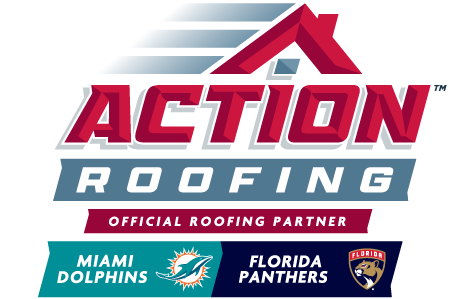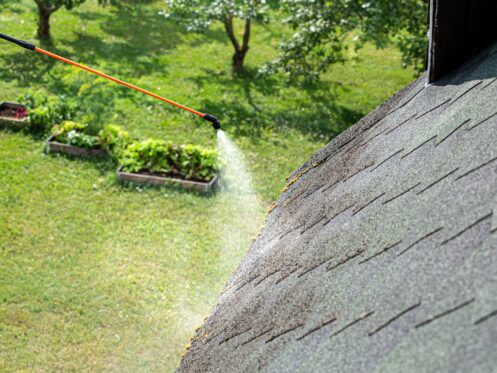Your roof is an integral part of your home. Your first defense against hail, wind, and rain, your roof protects your home from the elements, but when it is damaged, other parts of your home can suffer from moisture-related damage, too. Unfortunately, the constant exposure to humidity, rain, and dampness can lead to algae and moss, especially in Florida, and they can lead to costly damage.
In this guide, we will take a deeper look at both moss and algae and explore ways that you can protect your roof from moisture-related damage while reducing the risk of algae and moss growth.
Algae on Your Roof
You can’t spot every type of roof damage from the ground, but algae growth is typically easily visible. If you can see dark marks streaking across your shingles, you likely have algae on your roof. The algae growth damages the shingles by eating the limestone found in the shingles. Once the shingles are damaged, they’ll more easily absorb heat, which reduces the energy efficiency of your home and increases your monthly energy bills until you remove the algae from your roof.
Algae growth is common in moist and humid areas, so if you notice areas where rainwater tends to pool on your roof, you’re more likely to notice algae, too. Green algae can appear as a lighter green, but it will otherwise look similar to dark green or black algae.
On its own, algae might not do major damage, and you might not be overly concerned about it. But as it grows, it will trap moisture on your roof, promoting the growth of moss. Together, algae and moss will create a slippery and potentially dangerous surface that will need to be addressed by a professional roofing company.
Moss on Your Roof
Like algae, moss is visible once it begins to grow on your home’s roof. A non-flowering plant, moss tends to grow in damp, moist, shady places. Moss most commonly grows on porous, organic surfaces, like trees or earthy spots, but it can occasionally work its way onto the surface of your roof.
If you have moss on your roof, you will notice a thick layer of greenery that might look similar to a green carpet on your shingles. Unlike many plants, moss spreads through spores that travel through the wind. When a surface is ideal for moss growth, it will spread quickly. Moss is critical for moss to flourish since moss cells must swim to reproduce.
Moss can grow unnoticeably for long periods, and it prefers damp places, which means it often starts beneath the surface of the shingles. You could have a moss problem well before you can see it. As it grows, it strips away the protective weatherproofing layers on the shingles, and it absorbs water, deteriorating the shingles on both the underside and top surfaces. The excess moisture can also rot the roof deck and underlying wooden structures of the roof, allowing moisture to penetrate deeper into the structure of your home. Left ignored, you will eventually need major roof repair service that costs much more than managing the moss to begin with.
Extra Moisture Creates Mold on Your Roof
Algae and moss growing on your roof create excess moisture, which will lead to the perfect environment for mold, a fungal organism. Much like algae and moss, mold travels through the air via spores, and if the environment is significantly damp and humid, mold can take hold and flourish. Once it does, it spreads quickly atop moist surfaces.
Mold appears as patchy spots on your roof, which might appear chalky white, gray, green, or black. Once mold begins to grow on the surface of your roof, it will spread and can infiltrate your home, and spores can spread throughout the house, affecting air quality, too. Mold can negatively impact air quality, leading to respiratory infections, allergies, asthma symptoms, and other common health effects.
Algae and Moss Prevention
Once you understand how algae and moss can affect your roof, you will understand how critical prevention is to your home’s integrity and your family’s well-being. You have several options for preventing the growth of algae, moss, and mold, and they all start with controlling moisture. Here’s what you need to know to protect your roof, home, and family.
Remove All Organic Matter
During the year, organic matter, like leaves, tree branches, and twigs, can find its way to the surface of your roof and your gutters. This matter may already have mold, algae, and moss or their spores on them, making it easy to spread them to your roof’s surface. Regularly inspecting your roof for excess organic debris and removing it as soon as possible is critical to preventing algae-related issues. This is not a DIY job: Remember that algae and moss can make roofs extremely slippery. Professional roofers can quickly and efficiently inspect your roof and remove organic buildup, cleaning your roof and gutters of all materials potentially harboring mold, moss, and algae growth.
Install Zinc or Copper Roof Strips
Installing zinc and copper strips on your roof can help reduce the incidence of algae and moss growth. When it rains, water flows over these strips, releasing minute amounts of copper or zinc ions. These ions are toxic to moss and algae and prevent their growth as well as the growth of mold. By installing these strips, you can prevent the growth of all three problem substances and keep your roof strong and trouble-free for years.
Consider Algae-Resistant Shingles
When it is time to upgrade the shingles on your roof, consider an algae-resistant option that will help keep algae at bay. These shingles contain copper and zinc granules, so algae will have a more difficult time growing on them. This is a great option to protect your home, especially since the Fort Lauderdale area is often humid and moist.
Chemical Treatments
Chemical treatments are not always safe for the environment, so make sure that you consult with a professional on our team to get more information about how we get rid of algae and moss safely. Never use bleach to kill spores that you find on your roof; let the professionals handle it.
Increase Roof Ventilation
Since this growth is occurring on your roof, increasing the ventilation from your attic can help to ensure that this organic matter is unable to grow in the first place. The less moisture that remains in your home, the less chance there is for algae and moss to grow on the roof. This will also increase airflow, which is a good way to boost the air quality in your home.
Contact a Dependable Roofing Company Today
When you live in a humid area like Fort Lauderdale, your roof will need regular maintenance to ensure that algae and moss are not becoming an issue. At Action Roofing, we suggest having a professional from our team come to your home twice a year to perform a roof inspection and maintenance. Our team has decades of experience, and with that, we have earned the trust of residents in the Fort Lauderdale area. Contact us today for all of your roofing needs!




